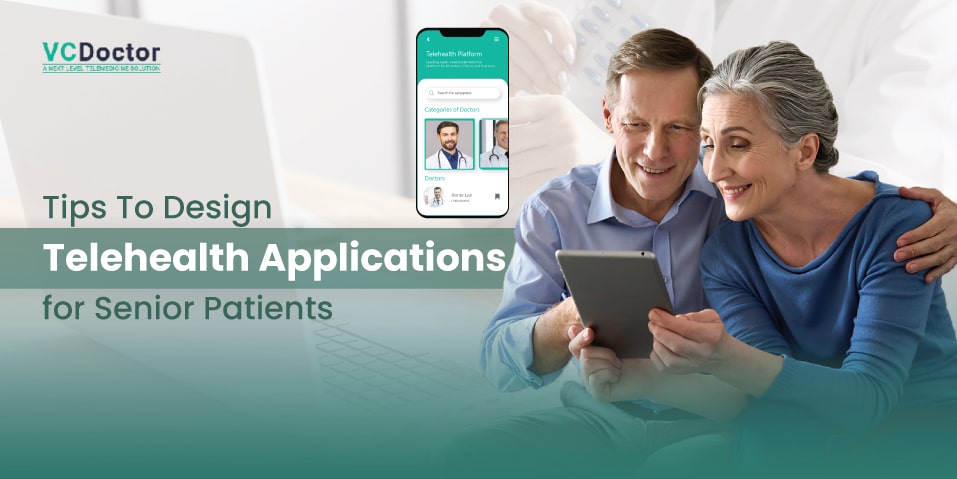Tips To Design Telehealth Applications For Senior Patients
 VCDoctor
VCDoctor
In recent years, telehealth has emerged as a transformative technology in the healthcare industry, offering convenience and accessibility to patients, particularly seniors. As the population ages and digital health solutions become more prevalent, designing telehealth applications that cater specifically to senior patients requires careful consideration of their unique needs and challenges. In this blog post, we will explore essential tips and considerations for designing telehealth applications that are user-friendly, intuitive, and effective for senior patients.
Understanding the Needs of Senior Patients
Designing telehealth applications for senior patients begins with a deep understanding of their specific needs and characteristics. Here are some key considerations:
Accessibility: Many seniors may have vision or hearing impairments, arthritis, or other physical limitations affecting their technology use. Design interfaces with large fonts, high-contrast colors, and intuitive navigation to accommodate these challenges.
Simplicity: Keep the user interface (UI) and user experience (UX) simple and straightforward. Avoid clutter and complex menus. Use clear instructions and minimize the number of steps required to complete tasks.
Compatibility: Ensure that the telehealth application is compatible with a variety of devices, including smartphones, tablets, and desktop computers. Consider providing options for voice commands or touchscreen gestures for easier interaction.
Clear Communication: Use plain language and avoid medical jargon. Provide easy-to-understand instructions and explanations of procedures or treatments. Include visual aids or diagrams to enhance comprehension.
Safety and Security: Seniors may be concerned about their health information's privacy and security. Implement robust security measures, such as encryption and secure authentication, to protect sensitive data.
Designing User-Friendly Interfaces
Creating a user-friendly interface is crucial to the success of telehealth applications for senior patients. Here are tips for designing intuitive interfaces:
Large Buttons and Icons: Design buttons and icons that are large and easy to tap or click. Use recognizable symbols and avoid complex gestures.
Consistent Layout: Maintain a consistent layout throughout the application. Place important functions in easily accessible locations and minimize the need for scrolling or zooming.
Color Contrast: Use high contrast colors between text and background to improve readability. Avoid color combinations that may be difficult for seniors with color vision deficiencies.
Feedback and Confirmation: Provide visual and auditory feedback when actions are performed. Use confirmations for critical actions to reduce errors.
Font Size and Type: Choose fonts that are easy to read, such as sans-serif fonts like Arial or Helvetica. Use a larger font size than standard to accommodate varying visual acuity.
Incorporating User Support and Assistance
Telehealth applications should include features that offer support and assistance to senior patients throughout their user journey. Here are ways to enhance user support:
Onboarding Tutorials: Provide step-by-step tutorials or walkthroughs to help seniors familiarize themselves with the application's features and functions.
Help and Support Section: Include a dedicated help section with FAQs, troubleshooting tips, and contact information for technical support.
Personalized Assistance: Offer options for personalized assistance, such as live chat support or telephone helplines, for seniors who may need additional guidance.
Accessible Help Buttons: Place help buttons or icons prominently within the application interface to allow users to access assistance easily.
Integrating Remote Monitoring and Communication Tools
Effective telehealth applications for seniors should facilitate seamless communication and remote monitoring between patients and healthcare providers. Consider the following integration tips:
Video Conferencing: Incorporate easy-to-use video conferencing capabilities for virtual appointments with healthcare professionals. Ensure compatibility with different internet speeds and devices.
Messaging and Alerts: Implement messaging features for secure communication between patients and caregivers. Include alerts for appointment reminders, medication schedules, or health monitoring prompts.
Health Data Monitoring: Integrate tools for remote monitoring of health metrics, such as blood pressure, heart rate, or glucose levels. Provide visual representations of data trends for easy interpretation.
Medication Management: Include features for medication reminders and tracking. Allow seniors to input medication schedules and receive alerts for dosage times.
Conducting Usability Testing and Gathering Feedback
Usability testing and gathering feedback from senior users are essential steps in refining telehealth applications. Here’s how to ensure usability and gather valuable insights:
User Testing: Conduct usability tests with a diverse group of senior participants to identify usability issues and gather feedback on the application's functionality.
Feedback Mechanisms: Implement feedback mechanisms within the application, such as surveys or feedback forms, to collect user insights and suggestions for improvement.
Iterative Design Process: Use iterative design processes to incorporate user feedback and continuously improve the application's usability and performance.
Accessibility Audits: Conduct accessibility audits to ensure compliance with accessibility standards and guidelines, such as the Americans with Disabilities Act (ADA).
Conclusion
Designing telehealth applications for senior patients requires a thoughtful approach that prioritizes accessibility, simplicity, and user-friendliness. By understanding the unique needs of seniors and implementing intuitive interfaces, user support features, and effective communication tools, developers can create telehealth solutions that enhance access to healthcare services and improve the overall quality of life for senior patients. Through continuous usability testing and feedback gathering, telehealth applications can evolve to meet the changing needs and expectations of senior users in the digital age.
Incorporating these tips and considerations into the design process will help ensure that telehealth applications effectively serve the senior population, promoting independence, convenience, and enhanced healthcare outcomes through technology. As the field of telehealth continues to grow, so too will the opportunities to innovate and improve healthcare delivery for seniors around the world.
Blog Source: https://www.vcdoctor.com/blog/telehealth-application/
Subscribe to my newsletter
Read articles from VCDoctor directly inside your inbox. Subscribe to the newsletter, and don't miss out.
Written by

VCDoctor
VCDoctor
Telemedicine is more than just a secure video call. When virtual communication is seamless, you can focus on what matters most – providing the best patient care. HIPAA Compliant Telemedicine Software VCDoctor is one of the Best Telemedicine Platforms that provides the telemedicine software app solution providers need for streamlining workflows and engaging patients. Call us for a DEMO!